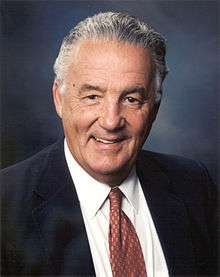Paul Sarbanes
Paul Spyros Sarbanes (born February 3, 1933) is a former American politician and attorney. A member of the Democratic Party from Maryland, he served as a member of the United States House of Representatives from 1971 to 1977 and as a United States Senator from 1977 to 2007. Sarbanes was the longest-serving senator in Maryland history until he was surpassed by Barbara Mikulski by a single day when her term ended on January 3, 2017.[lower-alpha 1]
Paul Sarbanes | |
|---|---|
 | |
| United States senator from Maryland | |
| In office January 3, 1977 – January 3, 2007 | |
| Preceded by | John Glenn Beall Jr. |
| Succeeded by | Ben Cardin |
| Chair of the Senate Banking Committee | |
| In office June 6, 2001 – January 3, 2003 | |
| Preceded by | Phil Gramm |
| Succeeded by | Richard Shelby |
| Member of the U.S. House of Representatives from Maryland's 3rd district | |
| In office January 3, 1973 – January 3, 1977 | |
| Preceded by | Edward Garmatz |
| Succeeded by | Barbara Mikulski |
| Member of the U.S. House of Representatives from Maryland's 4th district | |
| In office January 3, 1971 – January 3, 1973 | |
| Preceded by | George Hyde Fallon |
| Succeeded by | Marjorie Holt |
| Member of the Maryland House of Delegates from the 2nd district | |
| In office January 18, 1967 – January 13, 1971 | |
| Personal details | |
| Born | Paul Spyros Sarbanes February 3, 1933 Salisbury, Maryland, U.S. |
| Political party | Democratic |
| Spouse(s) | Christine Dunbar |
| Children | 3 (including John) |
| Education | Princeton University (BA) Balliol College, Oxford (BA) Harvard University (LLB) |
| Signature | |
Born in Salisbury, Maryland, Sarbanes is a graduate of Princeton University, Balliol College, Oxford, and Harvard Law School. Elected to the Maryland House of Delegates in 1966, he went on to serve two terms in the Maryland House from 1967 to 1971. In 1970, he won a seat in the United States House of Representatives, representing Maryland's 4th and later Maryland's 3rd congressional district from 1971 to 1977. In 1976, he ran for the United States Senate, defeating Republican incumbent John Glenn Beall, Jr. with 59% of the vote. Sarbanes was re-elected four times, each time receiving no less than 59% of the vote. He did not seek re-election in 2006, when he was succeeded by fellow Democrat Ben Cardin. Sarbanes was known for his low-key style,[1] often shunning the limelight over his 30-year Senate career. In 2002, Sarbanes co-sponsored the Sarbanes–Oxley Act, which is cited as his most-noted sponsored piece of legislation.[2][3]
Early life and family

Paul Sarbanes was born on Maryland's Eastern Shore in the city of Salisbury to Greek immigrant parents, Matina (née Tsigounis) and Spyros P. Sarbanes, who had emigrated from Laconia, Greece and owned a Salisbury restaurant.[4]
A graduate of Wicomico High School in Salisbury, Maryland, Sarbanes attended Princeton University, earning a bachelor's degree in 1954 from the Woodrow Wilson School of Public and International Affairs after completing a senior thesis titled "The Smith Act: A Denial of American Freedoms".[5] As a senior, he received the Moses Taylor Pyne Honor Prize, Princeton's highest undergraduate honor.[6] He also was awarded a Rhodes Scholarship that brought him to Balliol College of the University of Oxford in Oxford, England, graduating with a First Class degree in 1957. Sarbanes then returned to the United States and attended Harvard Law School.
After graduating in 1960, he clerked for Federal Judge Morris A. Soper before entering private practice with two Baltimore, Maryland law firms. In June 1960, Sarbanes married Christine Dunbar of Brighton, England; they have three children (John Sarbanes, Michael Anthony Sarbanes, and Janet Matina Sarbanes) and seven grandchildren. Christine Sarbanes died of cancer on March 22, 2009. Sarbanes holds the highest lay office in the Greek Orthodox Church, "Order of St. Andrew, Archon of the Ecumenical Patriarchate"[7] and is a member of the Greek Orthodox Cathedral of the Annunciation in Baltimore.[8]
His son, John Sarbanes, won the general election for Maryland's 3rd congressional district in 2006, the district that Paul Sarbanes represented prior to his election as senator.
Political career
In 1966, Sarbanes ran for the Maryland House of Delegates in Baltimore City and won. During his four years as a State delegate in Annapolis, Maryland he served on both the Judiciary and the Ways and Means Committees.[8]
He was elected to the United States House of Representatives in 1970 from the fourth district of Maryland and was reelected in 1972 and 1974 from the third district. While in the House, Sarbanes served on the Judiciary Committee, the Merchant Marine and Fisheries Committee, and the Select Committee on House Reorganization. As a member of the Judiciary Committee he participated in the Impeachment process against Richard Nixon. On July 26, 1974, he introduced the first articles of impeachment against President Nixon for obstruction of justice.[9]



In 1976, Sarbanes was elected to the United States Senate and re-elected in 1982, 1988, 1994 and 2000. In 2002, Sarbanes was the Senate sponsor of the Sarbanes-Oxley Act of 2002, which reformed federal securities laws in the wake of the 2002 accounting scandals.
Sarbanes served on the following Senate committees:
- Ranking Member of the Banking, Housing and Urban Affairs Committee
- Ranking Member of the Special Whitewater Committee.
- Senior Member Foreign Relations Committee.
- Senior Member Budget Committee.
- Senior Member Joint Economic Committee.
By 1981, Sarbanes was noted as a frequent critic of military budgets. In spite of this, in May of that year, he voted in favor of approving a Reagan administration-backed $136.5 billion military authorization bill.[10] In December, he voted in favor[11] of an amendment to President Reagan's MX missiles proposal that would divert the silo system by $334 million as well as earmark further research for other methods that would allow giant missiles to be based.[12] While the military authorization bill was seen as supporting the administration,[10] the December vote was viewed as a rebuff of Reagan.[12][13]
On March 11, 2005, Sarbanes, the longest-serving senator in Maryland history, announced at a news conference his decision not to seek re-election in 2006.[14] Colleagues of Sarbanes said that the reason for his retirement from the Senate was due to his annoyance with not having any leadership roles on committees.[15] When the 110th Congress convened in 2007, he was succeeded by fellow Democrat Ben Cardin who won the 2006 election.
The Senator received the Foreign Language Advocacy Award in 2007 from the Northeast Conference on the Teaching of Foreign Languages in recognition of his lifelong commitment to the values, languages, and cultures of the ancient world in service to the modern world.[16]
Election history
| Year | Office sought | Election | Subject | Party | Votes | % | Opponent | Party | Votes | % | ||
|---|---|---|---|---|---|---|---|---|---|---|---|---|
| 1970 | Maryland's 4th congressional district | General | Paul Sarbanes | Democratic | 93,093 | 69.7% | David Fentress | Republican | 40,442 | 30.3% | ||
| 1972 | Maryland's 3rd congressional district | General | Paul Sarbanes | Democratic | 93,218 | 83.8% | William Matthews | Republican | 17,967 | 16.2% | ||
| 1974 | Maryland's 3rd congressional district | General | Paul Sarbanes | Democratic | 54,936 | 70.1% | Republican | 23,491 | 29.9% | |||
| 1976 | U.S. Senator, Class 1 | General | Paul Sarbanes | Democratic | 772,101 | 59.3% | John Glenn Beall, Jr. (incumbent) | Republican | 530,439 | 40.7% | ||
| 1982 | U.S. Senator, Class 1 | General | Paul Sarbanes | Democratic | 707,356 | 63.5% | Lawrence Hogan | Republican | 407,334 | 36.5% | ||
| 1988 | U.S. Senator, Class 1 | General | Paul Sarbanes | Democratic | 999,166 | 61.8% | Alan Keyes | Republican | 617,537 | 38.2% | ||
| 1994 | U.S. Senator, Class 1 | General | Paul Sarbanes | Democratic | 809,125 | 59.1% | Bill Brock | Republican | 559,908 | 40.9% | ||
| 2000 | U.S. Senator, Class 1 | General | Paul Sarbanes | Democratic | 1,230,013 | 63.2% | Paul Rappaport | Republican | 715,178 | 36.8% |
Publications
References
- Both Sarbanes and Mikulski served five terms (30 years) in the Senate. However, due to a differing number of leap days over their tenures, Mikulski finished with 10,958 days of Senate service, to Sarbanes's 10,957 days.
- Charles Babington (March 12, 2005). "Cerebral Sarbanes Aloof to Limelight". washingtonpost.com.
- Greg Farrell (July 30, 2007). "The men behind the Sarbanes-Oxley Act". usatoday.com.
- Dick Carozza. "An Interview with Sen. Paul S. Sarbanes Sarbanes-Oxley Act Revisited". fraud-magazine.com.
- "Paul S. Sarbanes, U. S. Senator (bio)" (PDF). National Institutes of Health. Archived from the original (PDF) on May 28, 2010.
- Sarbanes, Paul Spyros (1954). The Smith Act: A Denial of American Freedoms (bachelor's). Princeton University.
- "Sophs receive study honors," The Daily Princetonian, 23 February 1954. http://theprince.princeton.edu/princetonperiodicals/?a=d&d=Princetonian19540223-01
- "Archbishop Demetrios presides at Investiture of Twenty-Two New Archons | Order of Saint Andrew the Apostle – Archons of the Ecumenical Patriarchate". Archons.org. October 26, 2008. Retrieved August 11, 2013.
- "Paul S. Sarbanes, U.S. Senator (Maryland)". Msa.md.gov. Retrieved August 11, 2013.
- Naughton, James M. (August 5, 1974). "How a Fragile Centrist Bloc Emerged As House Panel Weighed Impeachment". The New York Times. Based on reporting by the author, R. W. Apple. Jr., Diane Henry, Marjorie Hunter and David E. Rosenbaum. p. 49. Retrieved January 11, 2020.
- "Senate Votes Military Funds in Victory for Reagan". New York Times. May 15, 1981.
- "The 90–4 vote by which the Senate approved the..." UPI. December 3, 1981.
- Roberts, Steven V. (December 3, 1981). "Senators Reject Plan for Placing MX Missile in Silos". New York Times.
- Webbe, Stephen (December 4, 1981). "Reagan scorns Senate rejection of silo-based MX missile plan". The Christian Science Monitor.
- Kirkpatrick, David K. (March 12, 2005). "Senator Sarbanes, Maryland Democrat, Will Retire in '06". The New York Times.
- Kirkpatrick, David (March 12, 2005). "Senator Sarbanes, Maryland Democrat, Will Retire in '06". New York Times. Retrieved October 8, 2014.
- "The James W. Dodge Foreign Language Advocate Award". Northeast Conference on the Teaching of Foreign Languages. Archived from the original on August 21, 2014. Retrieved August 28, 2014.
External links
- United States Congress. "Paul Sarbanes (id: S000064)". Biographical Directory of the United States Congress.
- Appearances on C-SPAN
| U.S. House of Representatives | ||
|---|---|---|
| Preceded by George Hyde Fallon |
Member of the U.S. House of Representatives from Maryland's 4th congressional district 1971–1973 |
Succeeded by Marjorie Holt |
| Preceded by Edward Garmatz |
Member of the U.S. House of Representatives from Maryland's 3rd congressional district 1973–1977 |
Succeeded by Barbara Mikulski |
| Party political offices | ||
| Preceded by Joseph Tydings |
Democratic nominee for U.S. Senator from Maryland (Class 1) 1976, 1982, 1988, 1994, 2000 |
Succeeded by Ben Cardin |
| U.S. Senate | ||
| Preceded by John Glenn Beall Jr. |
U.S. Senator (Class 1) from Maryland 1977–2007 Served alongside: Charles Mathias, Barbara Mikulski |
Succeeded by Ben Cardin |
| Preceded by Al D'Amato |
Ranking Member of the Senate Banking Committee 1995–2001 |
Succeeded by Phil Gramm |
| Preceded by Phil Gramm |
Chair of the Senate Banking Committee 2001–2003 |
Succeeded by Richard Shelby |
| Ranking Member of the Senate Banking Committee 2003–2007 | ||
